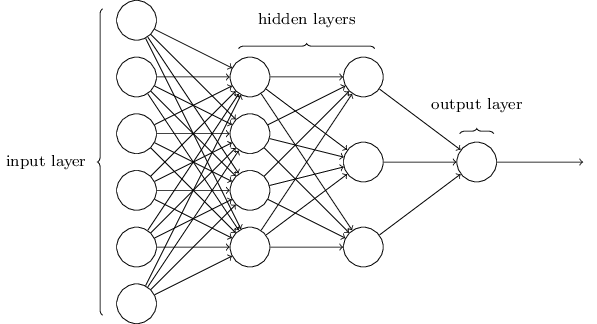Multi-Layer Perceptron
Mis à jour :
This post covers the history of Deep Learning, from the Perceptron to the Multi-Layer Perceptron Network.
1. Perceptron
Key idea (1958, Frank Rosenblatt)
- Data are represented as vectors
- Collect training data: some are positive examples, some are negative examples
- Training: find $a$ and $b$ so that
- $a > x + b$ is positive for positive samples $x$
- $a > x + b$ is negative for negative samples $x$
- Testing: the perceptron can now classify new examples.
Notes:
- This is not always possible to satisfy for all the samples
- Intuitively, it is equivalent to finding a separating hyperplane
Training the perceptron: At the time, ad hoc algorithm:
- Start from a random initialization
- For each training sample $x$:
- compare the value of $a > x + b$ and its expected sign
- adapt a and b to get a better value for $a > x + b$
Note: The perceptron is roughly inspired from the neuron:

Limitations: 1969, Perceptrons book, Minsky and Papert
- A perceptron can only classify data points that are linearly separable:
- Fail easy case such as the x-or function
Consequence: It is seen by many as a justification to stop research on perceptrons and entails the “AI winter” of the 1970s.
2. Multilayer Perceptron/Neural Network
Key idea (1980 - Rumelhart, Hinton, Williams) “Chain” several perceptron together at different depth, with the help of a “squashing” function.

Formalism:
- Input layer: $x$ is the same vector used for the perceptron.
- Hidden layer: consists of perceptrons + squashing function
- Perceptrons weight their input $Wx + b$, where $W \in \mathbb{R}^{perceptrons\times features}$
- Squashing / activation function $h = g(Wx+b)$ “rescales” the input for the next layer.
- Output: $y = W_{2}h+b_{2}$
Note: We can construct networks with arbitrary number of hidden layers, hence the usefullness of the activation function.
We can find $W, b, W_{2}$, and $b_{2}$ with the objective:
where $\mathcal{T}$ is the training set (features $x$ and expected output $d$).
Note: A Multilayer Perceptron solves non-linearly separable problems such as the x-or function with $g(a) = max(a, 0)$
In practice:
- Do NOT use a least-squares loss function for classification problems!
- There are no closed-form solution so we use gradient descent.
3. The Topology of the Functions Learned by Feedforward Networks
Universal Approximation Theorem Hornik et al, 1989; Cybenko, 1989
Any continuous function can be approximated by a two-layer network (with ReLU activation).
The function learned by a Deep Neural Network with the ReLU operator is:
- Piecewise affine
- Continuous
- Equations of the final regions are correlated, in a complex way

Laisser un commentaire